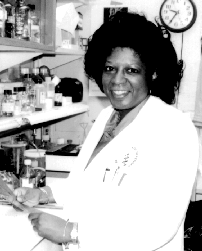 Sharon Jackson
Sharon JacksonThe American Federation for Clinical Research Foundation recently honored Sharon Jackson, clinical associate for the Laboratory of Host Defenses at NIAID, with its Henry Christian Award for Excellence in Research. Jackson received the recognition for her abstract "Mouse Model of Chronic Granulomatous Disease (CGD): the p47[phox] Knock-out" - one of only 15 abstracts chosen for the prestigious award out of 1,200 submitted for the Clinical Research meeting on May 6 in San Diego.
Jackson came to NIH in 1991 after finishing her residency at Mount Sinai Medical Center in New York. She received her M.D. from the State University of New York at Buffalo School of Medicine, in 1988.
CGD is a genetic disorder of the bactericidal function of the white blood cells that is characterized by widespread granulomatous lesions of the skin, lungs, and lymph nodes, as well as life-threatening bacterial and fungal infections. Patients with CGD are unable to produce superoxide, hydrogen peroxide, and other reactive oxygen metabolites due to a deficiency in any of the four proteins that make up nicotinamide adenine dinucleotide phosphate (NADPH) oxidase.
Under the guidance of the Laboratory of Host Defenses' Steve Holland and John Gallin, Jackson created a mouse model of the major autosomal-recessive (p47[phox]) form of CGD by using homologous recombination. A neomycin-resistance gene was inserted into the mouse p47[phox] gene and transfected into embryonic stem cells. Neomycin-resistant colonies were cloned and transferred into blastocysts that developed into fertile chimeras, which were then bred to produce p47[phox]-deficient "knock-out" mice. The knock-out mice could not be physically distinguished from their wild-type and heterozygous littermates. However, 50% of the knockout mice, by 14 weeks of age, developed spontaneous infections, while their wild-type and heterozygous littermates did not. Most of the knock-out mice have developed systemic infections with Staphylococcus xylosus. Based on these findings, the p47[phox] knock-out mouse appears to provide an accurate model of human CGD. Such a model will be useful for studying CGD gene therapy, and the role of hydrogen peroxide production by phagocytes in malignant transformation, cataract formation, arthritis, atherosclerosis, and other disorders.
- Lorna Heartley